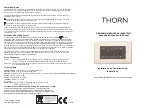
In addition to providing end-to-end OAM in native Layer 2 Ethernet Service Provider/Metro networks, you
can also use CFM to manage and troubleshoot any Layer 2 network including enterprise, datacenter, and
cluster networks.
Maintenance Domains
Connectivity fault management (CFM) divides a network into hierarchical maintenance domains, as
shown in the following illustration.
A CFM maintenance domain is a management space on a network that a single management entity owns
and operates. The network administrator assigns a unique maintenance level (from 0 to 7) to each
domain to define the hierarchical relationship between domains. Domains can touch or nest but cannot
overlap or intersect as that would require management by multiple entities.
Figure 2. Maintenance Domains
Maintenance Points
Domains are comprised of logical entities called maintenance points.
A maintenance point is an interface demarcation that confines CFM frames to a domain. There are two
types of maintenance points:
• Maintenance end points (MEPs) — a logical entity that marks the end-point of a domain.
• Maintenance intermediate points (MIPs) — a logical entity configured at a port of a switch that is an
intermediate point of a maintenance entity (ME). An ME is a point-to-point relationship between two
MEPs within a single domain. MIPs are internal to a domain, not at the boundary, and respond to CFM
only when triggered by linktrace and loopback messages. You can configure MIPs to snoop continuity
check Messages (CCMs) to build a MIP CCM database.
These roles define the relationships between all devices so that each device can monitor the layers under
its responsibility. Maintenance points drop all lower-level frames and forward all higher-level frames.
96
802.1ag
Summary of Contents for S4820T
Page 1: ...Dell Configuration Guide for the S4820T System 9 8 0 0 ...
Page 282: ...Dell 282 Control Plane Policing CoPP ...
Page 622: ...Figure 81 Configuring Interfaces for MSDP 622 Multicast Source Discovery Protocol MSDP ...
Page 623: ...Figure 82 Configuring OSPF and BGP for MSDP Multicast Source Discovery Protocol MSDP 623 ...
Page 629: ...Figure 86 MSDP Default Peer Scenario 2 Multicast Source Discovery Protocol MSDP 629 ...
Page 630: ...Figure 87 MSDP Default Peer Scenario 3 630 Multicast Source Discovery Protocol MSDP ...
Page 751: ...10 11 5 2 00 00 05 00 02 04 Member Ports Te 1 2 1 PIM Source Specific Mode PIM SSM 751 ...
Page 905: ...Figure 112 Single and Double Tag First byte TPID Match Service Provider Bridging 905 ...
Page 979: ...6 Member not present 7 Member not present Stacking 979 ...
Page 981: ...storm control Storm Control 981 ...
Page 1103: ...Figure 134 Setup OSPF and Static Routes Virtual Routing and Forwarding VRF 1103 ...
















































